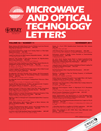A novel design of organic semiconductor thin film device embedded microstrip antenna
Abstract
Implanting an organic semiconductor thin film (OSTF) device into an inexpensive FR4 substrate to design a microstrip antenna is demonstrated in this article. When the substrate was grounded for the device, special features of the frequency dependent I–V curves and the PN junction built-in potential formed by joining of C60 (n-type) and CuPC (p-type) OSTFs can be obtained. The device can thus be activated and excited as a microstrip antenna by the side probe-fed simultaneously. Meanwhile, the antenna gains can be modified by changing the thin film thickness as well as the source voltage of probe-fed to excite the resonated mode of the structure of the microstrip antenna. © 2011 Wiley Periodicals, Inc. Microwave Opt Technol Lett 53:2569–2572, 2011; View this article online at wileyonlinelibrary.com. DOI 10.1002/mop.26338




